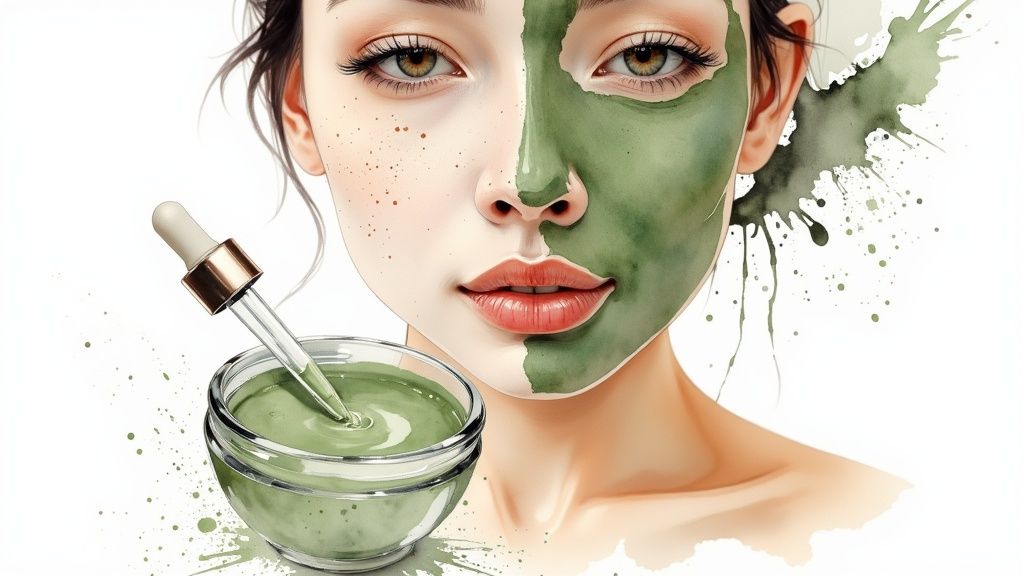
How to Get Rid of Blackheads for Good
If you're trying to get rid of blackheads, the secret isn't aggressive scrubbing or squeezing. It's about a smart, consistent skincare routine. The real heavy lifting is done by chemical exfoliants like salicylic acid, which gently dissolve what's clogging your pores. From there, it's all about using non-comedogenic products to make sure you're not just creating new clogs.
Why Blackheads Form and How to Stop Them
Before we can really tackle blackheads, we need to know what we're up against. It's a common myth that they're just little bits of dirt stuck in your skin. They're not. A blackhead, which is technically called an open comedo, is just a hair follicle that's gotten plugged up with a mix of dead skin cells and sebum—your skin's natural oil.
So, why are they black? It’s not dirt. The dark color is actually the result of oxidation. It’s a simple chemical reaction that happens when that gunk in your pore gets exposed to the air. This is what makes a blackhead different from a whitehead; a whitehead has a little layer of skin over the top, which stops the air from getting in and prevents that oxidation process.
This visual gives a great, simple breakdown of how blackheads and whiteheads differ.
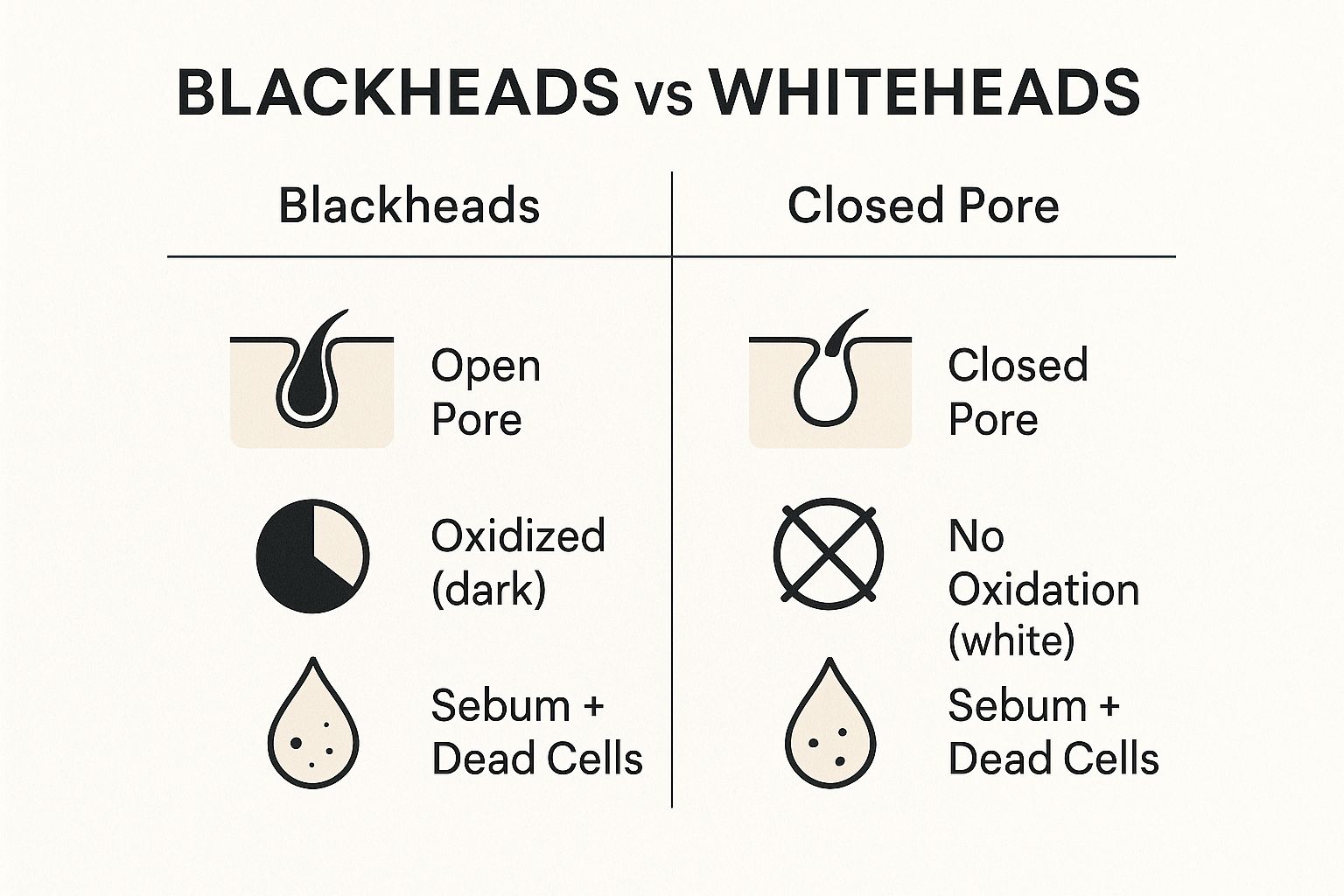
As you can see, it all comes down to whether the pore is open to the air or closed off. That one little detail changes everything about its appearance.
The Underlying Causes of Clogged Pores
So, what’s causing all this clogging in the first place? It’s rarely just one thing. Usually, a few different factors team up to create those pesky dots. Getting a handle on these triggers is the first real step toward preventing them. For a much deeper look, our guide on what causes clogged pores is a great resource.
Here are a few of the most common culprits I see in my clients:
- Hormonal Fluctuations: Big hormonal shifts—think puberty, that time of the month, or even just high-stress periods—can kick your oil glands into overdrive. More oil means a higher chance of a clog.
- Genetics: Sometimes, you just have to thank your parents. Your genes play a huge role in your skin type, how big your pores are, and your natural oil production levels.
- Improper Skincare: This is a big one. Using heavy, greasy products or not cleansing properly at the end of the day leaves a film on your skin that can easily lead to buildup in your pores.
If you’re dealing with this, you are far from alone. Blackheads are a type of non-inflammatory acne that a massive part of the population experiences. In fact, the global prevalence of acne vulgaris in teens and young adults shot up by nearly 40% between 1990 and 2021. This just goes to show how many people are looking for real solutions.
Once you understand what’s causing your blackheads, you can finally build a skincare strategy that actually works—one that gets rid of them for good.
Building Your At-Home Blackhead Treatment Routine
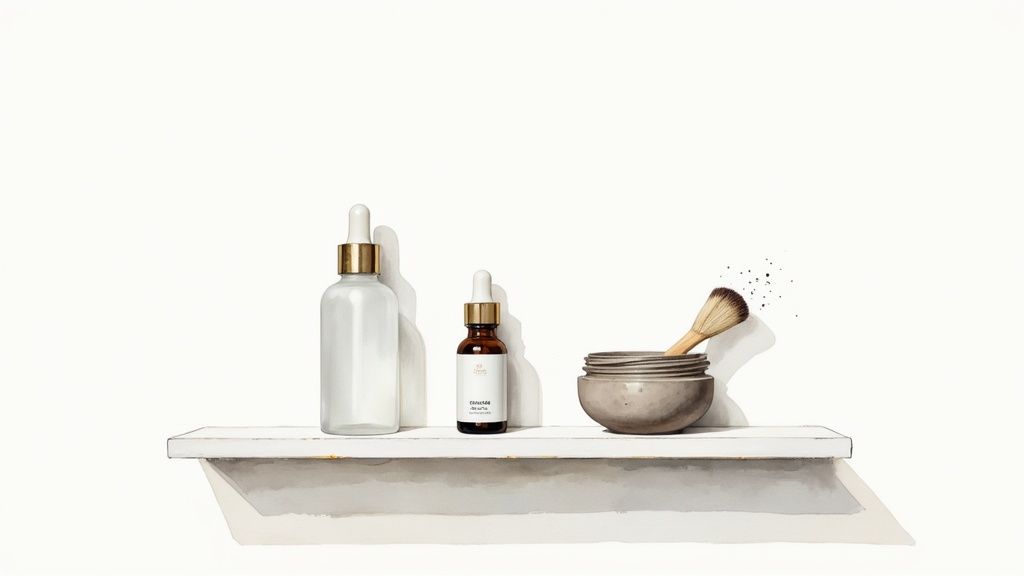
Putting together a solid game plan for tackling blackheads at home isn't about scrubbing your face raw with the harshest products you can find. It’s actually about being smart and consistent with the right ingredients. The real goal is a simple, sustainable routine that keeps pores clear without irritating your skin.
Think of a good at-home routine as your first line of defense. By focusing on a few proven, science-backed ingredients, you can dissolve the gunk already in your pores and, more importantly, stop new blackheads from forming. It's about getting to the root of the problem—that stubborn mix of oil and dead skin—for clearer skin that lasts.
Key At-Home Blackhead Treatment Ingredients
When you're standing in the skincare aisle, knowing which ingredients actually work can feel overwhelming. This table breaks down the heavy hitters you should be looking for.
| Ingredient | How It Works | Best For | Usage Frequency |
|---|---|---|---|
| Salicylic Acid (BHA) | An oil-soluble acid that gets deep into the pore lining to break down sebum and dead skin cells from the inside out. | Oily, combination, and acne-prone skin types. The gold standard for blackheads. | Start with 2-3 times per week, increasing as tolerated. Can be used daily by some. |
| Glycolic Acid (AHA) | A water-soluble acid that works on the skin's surface, dissolving the "glue" that holds dead skin cells together. | Normal to dry skin types. Great for improving overall texture and preventing clogs. | Begin with 1-2 times per week at night, as it can increase sun sensitivity. |
| Retinoids | Vitamin A derivatives that accelerate skin cell turnover, preventing dead cells from clogging pores in the first place. | Most skin types, but start with a low-strength OTC version. Essential for anti-aging too. | Start with a pea-sized amount 2-3 nights per week, gradually increasing frequency. |
| Clay (Bentonite/Kaolin) | A natural absorbent that acts like a magnet to pull excess oil, dirt, and debris out of the pores. | Oily and combination skin. Great for a weekly deep clean. | Once a week to avoid drying out the skin. |
Choosing the right ingredient depends entirely on your skin type and concerns. A BHA is fantastic for someone with classic oily skin, while someone with drier skin might benefit more from an AHA to smooth texture and prevent future clogs.
Weave Chemical Exfoliants into Your Routine
To really clear out a blackhead, you have to get inside the pore. That’s something a physical scrub just can't do, and it's exactly why chemical exfoliants are so essential.
- Salicylic Acid (BHA): This should be your go-to. Because it’s oil-soluble, it can travel deep into the pore and dissolve that hardened mixture of oil and skin cells that forms a blackhead.
- Glycolic Acid (AHA): This one works more on the surface, un-gluing dead skin cells. While it’s less direct than BHA for clearing existing blackheads, it’s fantastic for preventing new ones and giving your skin a smoother, brighter look.
If you have oily or acne-prone skin, adding one of these is non-negotiable. We've put together a full guide you can find here: https://oliveskintherapy.com/post/skincare-routine-for-oily-acne-prone-skin.
Pro Tip: When you first start using chemical exfoliants, ease into it. Try using them just two or three times a week at first. This gives your skin time to adjust and helps you avoid the redness and irritation that comes from overdoing it.
Add Retinoids and Masks for Extra Power
Once you have daily exfoliation covered, a couple of targeted treatments can really level up your results and help keep your skin clear for the long haul.
Topical retinoids are a powerhouse for managing blackheads. They work by putting your skin's cell turnover into high gear, which stops dead cells from hanging around and clogging up your pores. If you're new to them, start with a gentle over-the-counter retinol and only use it at night (and wear sunscreen during the day!).
Combining these modern treatments with classic ones is backed by solid research. Dermatologists frequently recommend retinoids alongside salicylic acid, and for good reason. Studies have shown that up to 85% of patients see an improvement within 4-6 weeks of consistent salicylic acid use. It really shows how a dedicated routine with the right ingredients pays off.
Clay masks are another great tool, perfect for a weekly deep-cleanse. A good bentonite or kaolin clay mask is fantastic at soaking up excess oil and pulling impurities out of your pores. Just pop one on your T-zone or all over for about 10-15 minutes once a week. You can also explore other helpful natural ingredients, like those covered in this article on 7 reasons to use Witch Hazel for acne.
Finally, do a quick check of all your products—moisturizers, sunscreens, and makeup. Make sure they are labeled "non-comedogenic." This is a simple but crucial step. It means the product has been formulated specifically not to clog pores, so you aren't accidentally undoing all your hard work.
Common Blackhead Removal Mistakes to Avoid
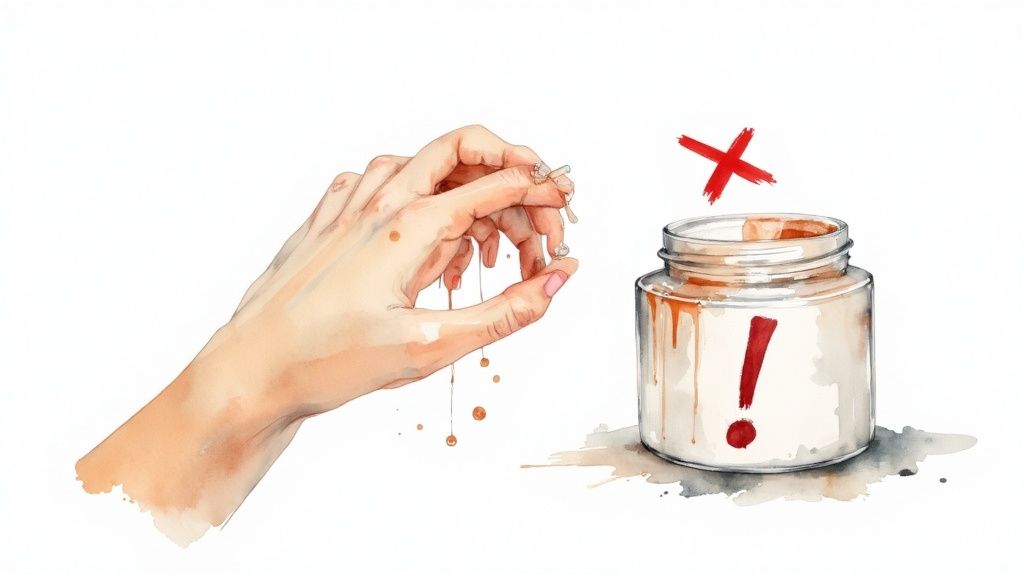
When you're staring down a cluster of blackheads, it’s incredibly tempting to take matters into your own hands. That frustration can lead to some pretty aggressive tactics that promise a quick fix but often backfire, causing much more harm than good.
Honestly, knowing what not to do is just as crucial as knowing which treatments actually work. Many of the most common "solutions" people try can strip your skin, trigger irritation, and even make oil production worse. Avoiding these pitfalls is the first step toward clearer skin that stays that way.
The Problem with Squeezing Blackheads
We’ve all been there. That urge to squeeze a blackhead is almost primal, but it’s one you really have to fight. When you go at it with your fingers, you're applying uneven pressure that can easily rupture the follicle wall deep under the skin's surface. This can shove all that gunk—oil, dead skin cells, and bacteria—even deeper.
What happens next? A major inflammatory response. The area gets red, swollen, and painful, effectively turning a simple blackhead into an angry, inflamed pimple or even a cyst. Over time, this trauma can permanently stretch out your pores or leave behind a small scar. It’s just not worth the fleeting satisfaction.
Squeezing doesn't just push debris deeper; it can also introduce new bacteria from your hands and create micro-tears in the skin. This invites infection and makes the whole situation take much longer to heal.
Why Pore Strips Are Not a Long-Term Solution
I get it, pore strips are incredibly satisfying. Peeling one off and seeing all those little black dots is convincing, but the results are purely superficial and short-lived. These adhesive strips only manage to rip out the very top, oxidized part of the clog. They almost never get to the root of the problem deep inside the pore.
What’s more, they don't just stick to the blackhead. They also yank out the fine, protective vellus hairs and the top layer of your skin cells, which can seriously irritate and damage your skin barrier. If you have sensitive skin or a condition like rosacea, this can trigger a whole new round of redness and inflammation. Ultimately, pore strips are a cosmetic illusion, not a real solution.
Over-Exfoliating with Harsh Scrubs
Thinking you can just scrub blackheads into oblivion is another huge mistake I see all the time. Using aggressive physical exfoliants with large, jagged particles—think crushed nutshells or coarse sugar—is like taking sandpaper to your face. These can create tiny micro-tears in your skin, compromising its natural protective barrier.
When your skin barrier is damaged, it’s left wide open to bacteria and irritation. This intense scrubbing also strips away your skin’s natural oils. The result? Your skin panics and goes into oil-production overdrive to compensate, leading to a vicious cycle of more clogged pores and more breakouts.
Instead, opt for gentle chemical exfoliants. A product with salicylic acid, for instance, works by dissolving the clog from within the pore, all without causing any physical trauma to your skin’s surface. It’s a much smarter, safer approach.
When It's Time to Call in a Professional for Stubborn Blackheads
A consistent at-home routine is your best first line of defense, but let's be real—sometimes it just isn't enough. If you’ve been battling deep, persistent, or widespread blackheads for months with little to show for it, that’s your skin sending a clear signal: it's time for professional backup.
Think of it like this: your daily skincare is like brushing your teeth, while a professional treatment is the deep clean you get from a dental hygienist. You absolutely need both for long-term health. A licensed esthetician or dermatologist has the training, high-grade tools, and seasoned expertise to tackle those stubborn clogs in a way you simply can't at home.
The Truth About Professional Extractions vs. At-Home Squeezing
One of the biggest draws of seeing a pro is getting safe, thorough extractions. This is worlds away from attacking your face with your fingers in a magnifying mirror. A professional uses sterile tools and precise techniques to apply even, gentle pressure around the pore, ensuring the entire blockage is removed without damaging the follicle or surrounding skin.
Squeezing at home? That’s a recipe for inflammation, scarring, and even infection. A pro knows exactly which blackheads are ready to be extracted and, just as importantly, which ones need to be left alone. That’s a judgment call that’s nearly impossible to make on your own.
The Bottom Line: Professional extractions are a controlled, clean procedure. At-home squeezing is basically uncontrolled trauma that often shoves bacteria deeper into the pore, turning a simple blackhead into a much bigger, angrier blemish.
Advanced Treatments for a Deeper Clean
Beyond manual extractions, professionals have an arsenal of advanced treatments that can seriously improve your skin's texture and stop future blackheads in their tracks. These services offer a level of deep cleaning you can't replicate at home.
- Chemical Peels: A pro-strength acid solution is applied to the skin, which works on a much deeper level than any over-the-counter product. It dissolves those stubborn plugs of oil and dead skin, essentially power-washing your pores from the inside out.
- HydraFacials: This popular treatment uses a special vortex-like suction device to cleanse, exfoliate, extract, and hydrate all in one go. It painlessly vacuums out your pores, giving you an immediate boost in clarity and smoothness.
These treatments act as a powerful reset button for your skin, making your daily at-home products work that much better.
It's completely normal to try and handle things yourself first. After all, acne affects about 9.4% of the global population, making it an incredibly common struggle. Many people try to manage blackheads on their own; for example, studies show that in some student groups with a high acne prevalence—around 78.5%—more than half (56%) self-medicate without any professional advice. This really highlights why it’s so important to know when to throw in the towel and seek expert help. As detailed in recent research from Nature, calling a pro is often the smarter, safer path to clear skin.
Lifestyle Habits That Help Prevent Blackheads
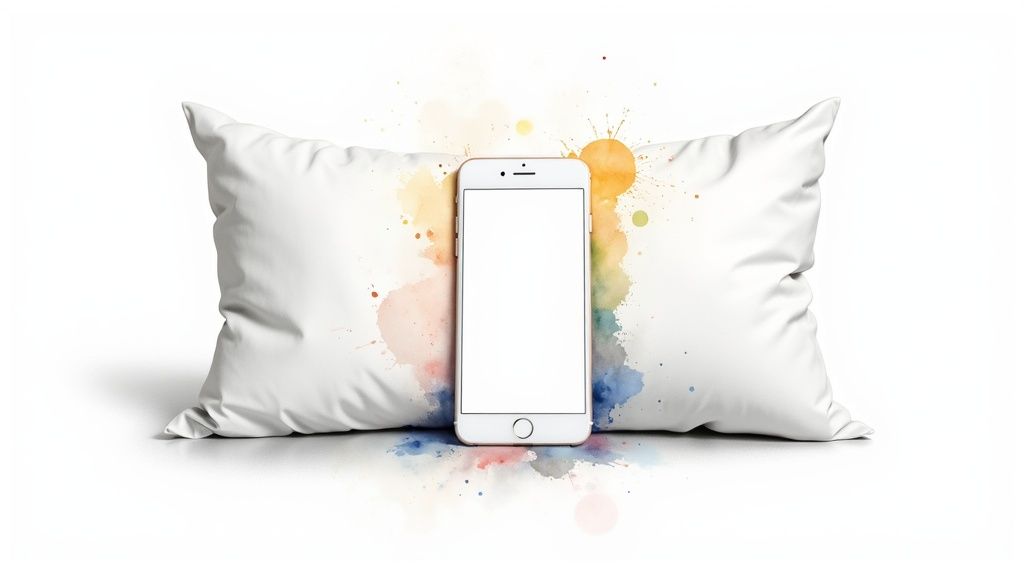
Cleansers and treatments are fantastic tools, but if you want to win the war against blackheads, you have to think bigger than just your skincare routine. The real secret to keeping them away for good lies in your daily habits.
Think of it this way: your lifestyle sets the stage for your skin's health. By being mindful of a few key things, you can create an environment where pores stay clear, preventing clogs before they even have a chance to form. It’s all about supporting the hard work your products are doing.
Your Diet's Role in Clear Skin
We’ve all heard "you are what you eat," and it’s especially true for our skin. The link between diet and oil production is very real, and for many people, certain foods are surefire triggers for clogged pores and inflammation.
High-glycemic foods are often the main culprits. Think white bread, sugary drinks, and processed snacks. These cause a rapid spike in blood sugar, which can kickstart a hormonal response that tells your skin to produce more oil. Some people also find that dairy has a similar pore-clogging effect.
Key Takeaway: You don't have to banish your favorite foods forever. The trick is to become a detective. When you experience a breakout, think about what you’ve been eating. Try cutting back on potential triggers and just observe. It’s all about figuring out what works for your body.
Simple Hygiene Habits That Pack a Punch
Sometimes the most powerful preventative measures are the simplest. We're constantly surrounded by things that can transfer oil and bacteria straight to our faces, creating the perfect storm for blackheads.
Just a few small adjustments to your routine can make a world of difference:
- Rethink Your Pillowcase: Your pillowcase collects a nightly buildup of oil, hair products, and dead skin. Swap it out at least twice a week to give your face a fresh surface to rest on.
- Wipe Down Your Phone: Let's be honest, our phones go everywhere with us—and they're filthy. Give your screen a daily wipe with an antibacterial cloth to stop transferring that grime to your jaw and cheeks.
- Hands Off!: This is probably the hardest habit to break, but it’s a big one. Every time you rest your chin on your hand, you're delivering bacteria and oil directly into your pores. This simple act can sabotage your progress, even if you're trying to figure out how to shrink large pores.
Be Smart About Makeup and Sunscreen
The products you leave on your skin all day are just as important as the ones you use to wash your face. Heavy makeup or greasy sunscreens can act like a plastic wrap, trapping oil, sweat, and dead skin cells right where you don’t want them.
Your new best friend is the word "non-comedogenic." It's a fancy way of saying a product has been formulated specifically not to clog pores. Always look for this label, especially on foundation, concealer, and sunscreen. For daily sun protection, mineral-based formulas are often a safer bet for acne-prone skin.
Beyond the basics, some people also find that activities promoting detoxification can support clearer skin. Exploring the potential infrared sauna skin benefits, for example, can be a great addition to a holistic skincare approach. By adopting these smarter habits, you're not just playing defense—you're actively building healthier, more resilient skin from the inside out.
Your Blackhead Questions Answered
Even with a solid game plan, it's normal to have questions about dealing with blackheads. You might wonder how long it really takes to see results, if they can ever be gone for good, or if those DIY hacks you see on TikTok are worth trying. Getting straight answers is key to setting realistic expectations and staying on track.
Let's dive into some of the most common questions we get from clients.
How Long Does It Take to Get Rid of Blackheads?
This is the big one, and the honest answer is that patience is your best friend here. While a great clay mask can make your pores look better right away, lasting change doesn't happen overnight.
Once you start a consistent routine with active ingredients like salicylic acid or a retinoid, you'll likely begin to see a real difference in about 4 to 8 weeks. Think of it as a marathon, not a sprint. These ingredients aren't just clearing the blackheads you have now; they're working deeper in the pore to regulate oil and prevent new clogs from ever forming. Consistency is everything.
Can I Permanently Remove My Blackheads?
In a word? No. And that's okay! You can't permanently "remove" blackheads any more than you can get rid of your pores or stop your skin from producing oil. Sebum production is a natural, healthy function of your skin, which means the potential for clogged pores will always be there.
The good news is, you can absolutely manage them so well that they become a non-issue.
The goal isn't a one-time cure but ongoing maintenance. A smart, consistent skincare routine is the closest thing to a "permanent" solution because it keeps your pores clear and happy day after day.
Are Blackheads a Sign of Dirty Skin?
This is one of the biggest myths out there, and it’s time to bust it for good. That dark spot you see is not dirt. It’s simply what happens when the gunk inside a clogged pore—a mix of natural skin oil (sebum) and dead cells—gets exposed to the air. It oxidizes, and that’s what makes it turn black.
Having blackheads has nothing to do with how well you wash your face. In fact, scrubbing your skin raw with harsh cleansers can make things much worse. Over-washing strips your skin's protective barrier, causing it to produce more oil to compensate, which can lead to even more clogs. Gentle is the way to go.
Do DIY Remedies Like Baking Soda and Lemon Juice Work?
Please, step away from the pantry. While DIY skincare can sound appealing and "natural," things like baking soda and lemon juice can wreak havoc on your skin. They can seriously damage your skin's acid mantle—the delicate, protective barrier that keeps moisture in and bacteria out.
Here’s a quick breakdown of why these are a bad idea:
- Baking Soda: It’s extremely alkaline, meaning its pH is way too high for your skin. Using it can disrupt your skin's natural balance, leading to severe dryness, irritation, and a weakened barrier.
- Lemon Juice: This is the opposite problem—it’s far too acidic. It can cause major irritation and make your skin much more sensitive to the sun, increasing your risk of sun damage and dark spots.
Stick to products that are properly formulated and pH-balanced for the face. It’s the only way to treat blackheads safely without creating a whole new set of problems.
Ready to stop guessing and start seeing consistently clear skin? The experts at Olive Skin Therapy build personalized treatment plans that deliver real, lasting results. Book your consultation today and start your journey to healthier skin.
